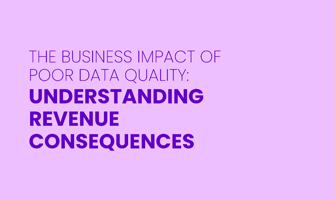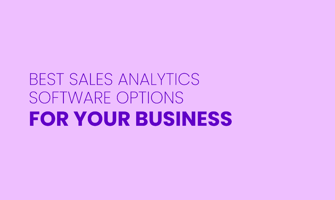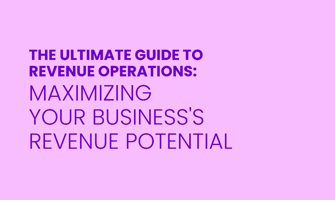Data quality impacts every aspect of a business, from decision-making and customer engagement to...
Revenue Intelligence: Build or Buy?
TEAMS VS. MACHINES
At the height of AI adoption, mid-cap and large enterprises are hiring analytics teams and consultants to develop new ways of turning data into insights. While this seems like a good solution on the surface, it often leads to a false sense of security—companies check the box, assume the problem is solved, and expect the team to handle it independently. But is that enough?
The Missed Opportunity
By relying solely on in-house analysts, companies often overlook a valuable, low-hanging fruit: advanced intelligence platforms that offer faster insights with lower costs and reduced risk.
For analytics professionals, these platforms can feel like a threat to job security. The fear is understandable, but it also creates resistance to adopting more efficient solutions.
The Incentive Problem
This problem is worsened when analytics work is billed by the hour. In these cases—especially with consultants or external teams—the incentive is not speed, but billable time. This misalignment slows progress and adds unnecessary costs.
This is why leadership must constantly evaluate what truly drives business growth. The best solution isn't choosing between people or platforms but finding the right synergy between the two.
The financial and timeline consideration
The following basic table highlights the cost differences between building an in-house analytics capability and using the 180ops revenue intelligence platform built on account-based data. Beyond the direct costs, there are also hidden expenses such as internal meetings, decision-making, and potential recruitment if a team isn't already in place.
|
FACTOR |
(ANALYST) TEAM AND RESOURCE REQUIREMENTS |
180ops PLATFORM |
|
Iteration and learning to get started |
Large investment (consulting, analyst, design, coding and tool costs as well as hiring costs for internal capability creation) |
Included in the fee (onboarding) |
|
Data model and tech dev. costs |
Large investment (design, coding, tech, licenses, tools...) |
Included in the fee (done and tested) |
|
Architecture and infra |
Large investment (consulting, design, technology, license and coding costs) |
Included in the fee (done and tested) |
|
Analyst tools and AI (ML/neural/NLP) development |
Tool & Dev cost + running costs |
Included in the fee (done and tested) |
|
Development of data recipe, iteration and learning |
Running development and analyst cost |
Included in the fee (Customer success collaboration. We have a lot to contribute to the data recipe development) |
|
Delivering data to other systems |
Integration and development cost |
Add-ons and ready-made API included in the fee |
|
Reporting tool development |
Investment + tool costs |
Included in the fee (done and tested) |
|
People onboarding and education |
Educational Material production and training costs |
Onboarding, training and tutorials included in the fee |
|
Data security |
Needs to be designed and built. Requires tech investments, development and licenses. |
Included in the fee (SSO, data security in full solution including encryption, secure data model, anomaly detection, intruder detection and extraction) |
|
Data ownership |
Fully owned |
Fully owned by customer |
|
Continuous analysis |
Mainly driven by analysts, distribution and design for users' needs to be designed and built |
UI included in the fee (done and tested) |
|
The cost of external data |
According to use cases and needs (the same as platform use) |
According to use cases and needs (the same as internal dev.) |
|
Support and documentation |
Who has the ownership of the overall solutions? Who owns the roadmap? What about documentation of various self-developed tools? What if the key person(s) decides to leave the company |
Included in the fee (support channels and tools, customer success responsible, full documentation) |
| Regulatory compliance | Internal requirements to stay compliant | Included in the fee |
Timeline and development perspectives
Choosing between custom development and a platform is like deciding whether to build a factory from scratch or lease a ready-made facility with established production, assembly, packaging, and delivery systems.
For mid-cap and large enterprises, this is a direct comparison—data volumes are massive, and the complexity of building an analytics solution is hard to grasp until you're deep in the process. From an investment standpoint, going in without a platform means stepping into an open-ended commitment—you won’t know the full cost or potential value until much later.
180ops is built for scalable, modular production. The core framework is standardized for efficiency, but every implementation is tailored—allowing flexibility in data configuration, ETL processes, and output structures to fit each customer’s unique needs. This ensures speed, adaptability, and value without the inefficiencies of fully custom development.
Instead of one-size-fits-all or from-scratch construction, we offer structured customization—leveraging decades of hands-on analytics expertise to deliver insights that are both industrialized and uniquely relevant to each business.
Here is how the 180ops revenue intelligence data factory actually works:

The Timeline Advantage
The time-to-value between these two approaches is stark:
- 180ops can be fully operational quickly, in as little as four weeks
- Custom development takes years to deliver real value—and even then, user experience lags behind what a dedicated platform can offer
Beyond implementation speed, platform-based solutions like 180ops continue evolving without incurring additional costs to the customer, whereas in-house development requires ongoing investment just to keep up, which will quickly exceed the 180ops license cost.
Even for companies that have already built custom analytics for risk, next-best-action (NBA), or potential modeling, 180ops can integrate those tools to solve usability and distribution challenges, all while reducing ongoing costs.
The True Challenge: Delivering Insights to the Right People
Analytics isn't just about getting the right answer. It’s about:
- Delivering the right insights
- To the right person
- At the right time
- In a format they can understand
- In the tools they already use
This is where 180ops excels—providing intuitive, scalable insights that drive real decisions, rather than just generating more reports.

What You See Is Just the Beginning
The biggest advantage of 180ops is that customers know what they’re getting up front. The platform provides high-value insights in a user-friendly format, but it’s not meant to replace internal teams or consultants—it works with them.
Companies will always need deeper analysis, qualitative research, and strategic interpretation. That’s where internal teams shine. Our platform simply ensures they spend more time acting on insights rather than struggling to generate them.
The Best of Both Worlds
A platform is the fastest, most cost-effective, and most reliable way to get the insights you need. Your team is the best at turning those insights into action—building narratives, shaping strategies, and driving business change.
180ops collaborates with multiple industries, continuously learning and optimizing to deliver the most valuable insights for each use case. Our ability to evolve and improve is far beyond what an individual company can achieve on its own.
As a customer, you’ll:
- Have full visibility into our development roadmap
- Be able to influence future features
- Continuously benefit from new capabilities—without additional costs
GET THE LATEST REVENUE INTELLIGENCE INSIGHTS FROM OUR NEWSLETTER
Subscribe to our newsletter to get the latest insights and updates on revenue intelligence, AI-driven analytics, and best practices for data-driven decision-making.




